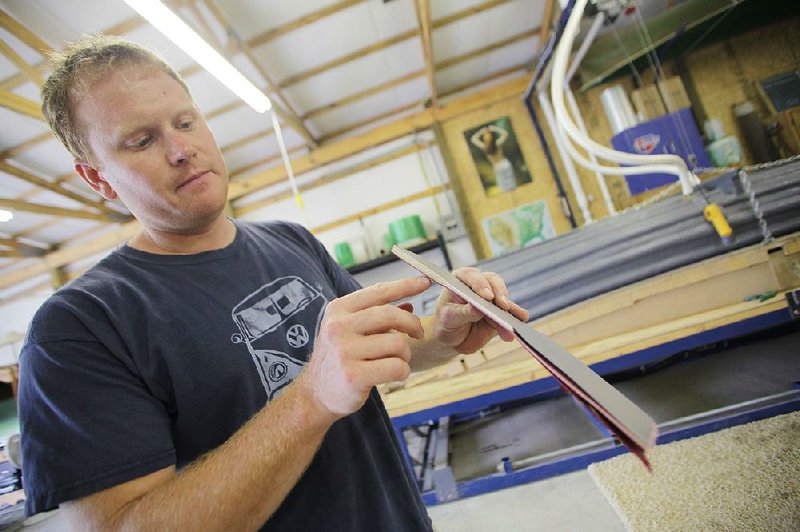When the supply of Royalex dried up years ago, Arkansas-based canoe makers who rely on the material found themselves up a creek without a paddle.
But these days, with the help of Canadian canoe company Esquif's replacement product dubbed T-Formex, two Northwest Arkansas canoe makers are back in business. T-Formex is a laminate made up of a foam core fixed between two sheets of ABS plastic, resulting in a surface that's rugged, keeps its shape and floats.
Louis Shaw, co-owner of Two Brothers Canoes in Rogers, said his canoe business has been pretty much idle for years because of the lack of material. He said with T-Formex acquired straight from Esquif, Two Brothers has been building canoes this year without having to retool.
Lewis Shaw and his brother William Shaw use a huge electric oven that heats a T-Formex sheet, then they vacuum-form the canoe using special molds. They make a canoe of their own design, the Arkoda, and are producing a second canoe, the Intrepid, under a licensing agreement with Tennessee-based canoe maker Mohawk. Both versions sell for about $1,800.
"It's going to be as good or better," Shaw said, comparing the new material to the industry's old standard, Royalex.
In early 2014, PolyOne Corporation, the sole supplier of Royalex, stopped production of the durable, inexpensive plastic material used to make hulls for canoes. That left many canoe makers, particularly smaller ones, looking for a replacement.
"We didn't know what our future would be," Shaw said.
In 2014, Esquif said it had developed T-Formex and would be producing it as a replacement for Royalex but later that year said it would be shutting down its plant in Frampton, Quebec. In May 2015, the company said it'd reached a deal with its creditors and it would produce both its own canoes in T-Formex and would also operate a dedicated sales branch for the product.
Odie Tucker, a category specialist for outdoor and shooting sports with Colorado-based SSI Data, said sales revenue from canoes last year was down about 4 percent overall to around $30 million, but unit sales were up about 3 percent to about 30,000. He said the average selling price varied between $600 to $800.
According to the 2015 Special Report on Paddle Sports by the Outdoor Foundation, 21.7 million Americans, or a little more than 7 percent of the nation's population, enjoyed some sort of paddling sport in 2014, up by 3 million from 2010. Kayaking of any type had the highest participation rate at 13 million with canoeing second at 10 million, rafting at third with 3.8 million and stand up paddling at 2.8 million.
Gary Gordon, owner of Buffalo Canoes in Jasper, said the loss of Royalex nearly drove him out of business but now that T-Formex is on the market, he has been making canoes since December. T-Formex, he said, was a bit more difficult to work with but it was harder, thicker and tougher than Royalex.
He has made 30 canoes so far and has sheets of T-Formex coming from Canada to make 50 more. He sells to area outfitters and the general public. The 16-foot canoes sell for $1,895.
"I'm back now," he said.
SundayMonday Business on 03/04/2018
